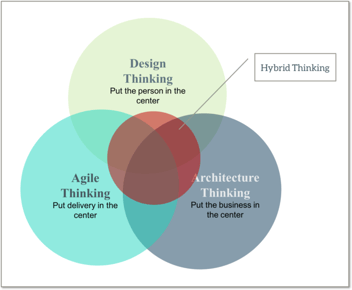Recently I was part of a follow-the sun presentation hosted by IASA. An interesting 24 hours of continual delivery of related content over a 24 hour window, from multiple parts of the world.
Within my talk I spoke about the need for hybrid thinking. It’s a term that we had to use to convey a certain message. There is a lot of talk about Design Thinking. Similarly there is a lot of talk about Agile thinking. And then you have some of the “older” disciplines like architecture, strategic planning and business planning. Let’s call this business or architecture thinking.
These disciplines are meant to unify the business and create a coherent organisation that delivers more valuable outcomes for customers in shorter time periods. The challenge is that the disciplines themselves don’t align. In fact each of these disciplines is encroaching on the others, laying claim to territory it now feels would add more value to its “framework” method or approach.
The long and short is that this does nothing to help stakeholders realise their objectives. What is needed are individuals and teams that don’t think in those spaces, but rather think in a space that mixes the good aspects from each of these disciplines into solid outcomes for stakeholders. This is half the problem with hierarchical structured organisations, positioning people into functional boxes where they must stay to deliver their value. However, what we are proposing is the creation of what we refer to as Super-mixers. Individuals that can cut across all these functional silos and not be classified as a designer, architect, analyst, or project manager. But rather as a growth facilitator or an efficiency expert. This is the realm of the Super-mixer.
I believe this is the future of work. You are beginning to see organizational models emerge to try and support this, like Holacracy. To get the greatest benefit from Super-mixers, you need to create a Super-mixer culture, with all the organisational ramifications that entails.
I’d be interested to hear from anyone out there who has tested models similar to holacracy. Ping us on our Facebook page or LinkedIn to provide comment. In the mean time, enjoy the presentation we gave to IASA.




